Scattered around Brownsville are several small tracts of land belonging to the Lower Rio Grande Valley National Wildlife Refuge, itself part of the South Texas Refuge Complex managed by the U.S. Fish and Wildlife Service.
Scattered around Brownsville are several small tracts of land belonging to the Lower Rio Grande Valley National Wildlife Refuge, itself part of the South Texas Refuge Complex managed by the U.S. Fish and Wildlife Service.
Although the tracts normally are off limits to the public, that could change if a USFW initiative to connect more residents to the outdoors gains traction here. Gisela Chapa, USFW coordinator for community engagement and partnerships for the South Texas complex, said the initiative began in 2014 to engage “nontraditional audiences.”
“People will travel all over the world looking for birds,” she said. “Those people are very motivated to visit places like refuges, whereas the nontraditional audiences — for instance the people that live within close proximity to the refuge — sometimes we get so busy with work and school and other stuff that we forget what’s really within our reach.
“We’ve observed that sometimes the people that live closest to the refuge don’t even know that they have that resource available to them. That doesn’t only happen down here in South Texas. I think that is something that happens across refuges, even national parks.”
Chapa, who previously managed the Santa Ana National Wildlife Refuge, also part of the South Texas complex, said the USFW’s “community connections” initiative in the Valley resulted in a partnership with the Pharr-San Juan-Alamo school district toward the creation of mini-refuges that serve as outdoor classrooms.
She worked with teachers to tie the “schoolyard habitats” to curriculum, and the program has branched out, with other Hidalgo County school districts and partners getting on board.
Earlier this year while transitioning into her new role, Chapa began looking for ways to take the USFW initiative beyond Santa Ana to other parts of the South Texas complex, which includes Laguna Atascosa National Wildlife Refuge and its affiliated Bahia Grande Unit.
In Cameron County, the initiative wouldn’t necessarily mirror Hidalgo County’s school-partnership approach, she said. Nothing is firm yet, though the initiative could take the form of refuge tracts around Brownsville being opened to families who want to try out various outdoor activities such as archery or kayaking, Chapa said.
She’s been in discussions with the city of Brownsville about the initiative, she said, noting that the city already has formed partnerships with USFW to connect the Bahia Grande to the hike-and-bike trail network envisioned in the city’s Active Transportation Plan.
Chapa said holding public events at refuges might be a good way to jumpstart the initiative in Brownsville.
“I think what would give some traction to the partnership and demonstrate the value would be if we had the opportunity to host events — and this will happen soon — where the community can be exposed to the outdoors and do things they haven’t done before,” she said.
“The locations are already there, whether they’re city parks or refuges. People already have a place to go visit and to go explore, we just have to take that a little bit further.”
Everything depends on funding, of course, and USFW will do whatever it can to support grant applications toward that end, Chapa said.
“I perceive that there’s interest within the city,” she said. “This is something that I’ve noticed with partnerships: There’s an intent and there’s interest, but there’s always a barrier, and the majority of the time, funding is a barrier.”
Ramiro Gonzalez, the city’s government affairs liaison, said the initiative is still in the idea stage, though one thing that’s certain is that — according to a national benchmark cited in the parks and recreation department’s master plan — Brownsville suffers a deficit of parkland based on its current and projected future population numbers.
Another fact is that USFW owns a great deal of refuge acreage within the city limits, he said. Finally, Brownsville’s population has a high incidence of health issues due in large part to a lack of physical exercise among residents, Gonzalez said.
“When you have that health challenge, there’s an obvious interest in working with partners to open up access to these lands,” he said. “How you go about that, that’s a longer process. That’s kind of the crux.”
Gonzalez said the city plans to “keep the lines of communication open” with Chapa and USFW.
“Wherever we can coordinate, then let’s coordinate,” he said.







